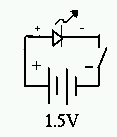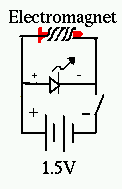

Not only can a current make a magnetic field, a changing magnetic field can try to make currents flow. This activity gives an example.
Assemble these materials:
Compare the behavior of these two circuits, where we will use only a single battery (1.5 V):
 |
In these diagrams, the switch just means that we don't permanently connect the battery into the circuit -- instead, just touch the battery wire to the other parts, to see what happens when you give the circuit a short jolt or a longer application of the voltage. Nothing is supposed to happen in the circuit at left -- the voltage is not big enough to operate the LED (but we check, anyway). |  |
The circuit at right is more interesting.
 Summarize what you learned in these
activities
Summarize what you learned in these
activities
Check the box when you are
done:
Next:Science content: electromagnetism